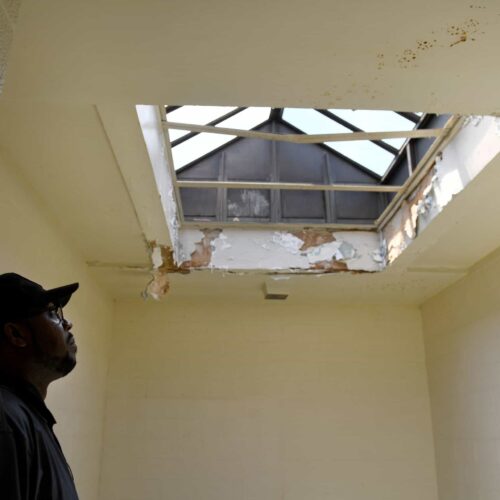Introduction
More than a decade ago, the U.S. Department of Housing and Urban Development estimated Congress needed to spend $26 billion on construction projects for the nation’s stock of aging public housing developments.
Now, after years of failing to address the problem, the backlog of unfunded capital projects has ballooned to an estimated $80 billion.
These types of projects include repairing damaged roofs, replacing broken heating and air conditioning systems and reconstructing aging sewage lines — projects that directly affect the health and safety of the 1.2 million families living in public housing units across the country.
Public housing developments are a key part of the safety net for a nation that has long been in the grip of an affordable housing crisis.
In February 2020, the Center for Public Integrity filed a Freedom of Information Act request with HUD for information about the long list of projects that are still waiting for funding and about the ones that have been completed.
Despite our repeated requests for updates, our request languished inside the bowels of HUD for 16 months before the Public and Indian Housing division reached out to discuss it. Public Integrity joined HUD officials on a call July 9 and reached an agreement on the information the agency would shortly provide.
Weeks turned into months. On Dec. 21, HUD provided a document as part of a minor “interim response,” but we still have not received the bulk of the information we requested. HUD said Thursday that it anticipated releasing more soon, citing a backlog of requests and a drop in FOIA officers as key reasons for the delay.
President Joe Biden’s proposed Build Back Better Act includes funding that would put a significant dent in the list of construction projects needed to keep public housing developments safe and sanitary. But the future of that money hangs in the balance after Sen. Joe Manchin III, D-W.Va., withdrew his support for the sweeping legislative agenda.
To put the need for capital funding into perspective, we talked to two people with the National Association of Housing and Redevelopment Officials: Tess Hembree, the director of congressional relations, and Eric Oberdorfer, interim director of policy and program development.
This interview was edited for length and clarity.

Public Integrity: How did we get into a situation where we have an estimated $80 billion backlog of construction projects?
Oberdorfer: What’s happened over the years is that the capital fund has been chronically underfunded each year, but I don’t even think that there was a realization on the side of Congress that that was occurring until about 2010. HUD was given a pretty substantial amount of money that year to do a study basically to determine how much money is in the backlog and then how much money Congress would need to appropriate each year to make sure all of the capital maintenance projects are completed in a calendar year.
Essentially what the report found was a backlog of $26 billion, and that for public housing agencies to be able to meet all of their capital needs each year, they need about $3.4 billion every year appropriated by Congress. There’s a pretty big discrepancy over what was provided versus the need. As a result, because of this underfunding, because of the fact that Congress has not met the obligation to fund the capital fund, we’ve seen the backlog grow pretty substantially year over year.
The longer you wait to do a large-scale capital needs project, the more expensive it becomes. Part of that is inflation, but also just think about if you have a roof on your house that needs to be fixed: If you fix it right away, it’s probably going to be easier to do than if you wait two years to fix it once you have enough money piled up so you can do that. The longer you wait to do these projects, the more expensive they become. We still have never hit that $3.4 billion that the 2010 study that HUD put out noted was needed to meet all of the capital needs across public housing.
Public Integrity: One of the things I’ve come across in reporting this story is that HUD doesn’t track the backlogged projects, so $80 billion is an estimate, right? From what I understand, housing authorities had the option of filling out a capital needs assessment each year, but it wasn’t mandatory, so there is no full accounting for what projects are needed. Is that correct?
Oberdorfer: Yes, that’s correct. The challenge that agencies have with physical needs assessments right now is that it is a time-consuming process to go through, it is expensive and the money isn’t there to be able to do it. One of the issues is that when you’re doing something like that, there’s still no guarantee that Congress is going to take any of that information and provide the appropriate level of funding so that those needs are met.
The 2010 study really demonstrated that, where HUD was able to go to Congress to say we need $3.4 billion appropriated annually to meet the needs and there’s a backlog of $26 billion. Congress still didn’t provide that funding, and in fact they cut the capital fund after that report came out. So there’s always a challenge when you’re dealing with limited resources and to figure out the best way to use those resources.
Public Integrity: What do you think someone who is managing properties in the private sector would do?
Oberdorfer: If you’re in the private sector and you have a big capital needs project, you can always go and take out another mortgage on the property. You can go to the bank. You can leverage the property for additional capital up front and then apply it to the building. Because of how public housing is structured, public housing authorities don’t have the ability to do that.
Public Integrity: The Build Back Better Act, at this point, sounds tenuous.

Hembree: Tenuous is probably a positive spin on where we stand right now. Obviously, Manchin dropped the bomb [in December] that he is a no on Build Back Better, despite the efforts of some of his colleagues to negotiate directly with him. So at this point we’re not entirely certain what path Build Back Better has. Chances are they’ll have to pare it down a bit to fit the concerns of Manchin. So at this point we’re waiting to see what leadership decides to do, given the realities that they have of having a functional majority without being an actual majority in the Senate.
I see some positive silver linings on this. One, a lot of the things Manchin has talked about being major concerns of his don’t really touch on the housing provisions, so I’m optimistic that if they do need to peel back some of the bill, that doesn’t really apply to the housing so maybe it can sneak in somewhere. But we’re going to have to be very mindful about aggressively pushing for housing to get included in the next iteration of whatever comes up.
Public Integrity: Can you put into context how significant this proposal is for public housing capital projects?
Hembree: I started NAHRO back in 2013, and we had the 2010 study and we knew there was a $26 billion backlog. We knew those backlogged projects were accumulating at a pretty high rate, because back then it was at the beginning of the Budget Control Act and the sequestration, all the major cuts that Congress did in the early teens, and we knew the problems were just going to get worse. We started messaging outside of the annual appropriations to get a little bit of additional funding for capital projects that we knew were really necessary across the country. We started asking for $25 million to deal with things like mold and lead paint, because given where we were with sequestration, we thought that was a realistic ask while still being a little bit of a stretch. We did succeed in 2014 or 2015. It was a drop in the bucket. We never really thought we’d be having a conversation about clearing the vast majority of the backlog. And so fast forward to today, the strides that we’ve made in the housing advocacy community in bringing awareness of the problem and awareness of how much funding is needed I think has been impressive to see.
The public housing model as it stands now with current funding level through annual appropriations, I fear that we’re going to lose too many units in the future. We’re really going to have a conversation about whether the public housing model is sustainable if they don’t do something like Build Back Better. It’s compensating for decades of underfunding and, frankly, congressional mismanagement of a program that they were on the hook to provide funding for. It’s dealing with the past while preserving the program for the future. It will be a momentous historic bill that we will talk about for generations if it does get passed.
Public Integrity: How important is public housing for the United States in terms of the affordable housing crisis?
Oberdorfer: There’s a little over a million families that are in public housing. What I always think about when I think of public housing is that it is — and I mean this literally — the only housing that is required to remain affordable in perpetuity. These are hard units. We know right now that we’re in a major housing shortage. We know the challenges in getting new units built. These are units that exist that are required to remain affordable for low income households across the country.
If Congress does not provide the funding necessary to make sure that public housing can continue to operate, we really lose something. Again, there are vouchers out there and vouchers are critical, but public housing is the only affordable housing that we have in this country that is not dependent upon what is happening in the market. These are hard units that are there, that exist, and I think it’s the duty of Congress to make sure that public housing agencies are able to maintain and operate these units to the best of their abilities with an adequate amount of funding to do so.
Hembree: When we say the future of public housing is at risk, I don’t necessarily mean that one day the units will go offline and people will have to move out. It’s a gradual attrition. The 2010 study said we’re losing about 10,000 units per year of public housing. When you think about the reality of how that happens, that means the units gradually over time have gotten to a point where they are unfit for families to live in.
There are still a lot of families living in conditions that are getting to that point, and it’s unfair because Congress can’t provide adequate funding to ask them to live in those units.
Help support this work
Public Integrity doesn’t have paywalls and doesn’t accept advertising so that our investigative reporting can have the widest possible impact on addressing inequality in the U.S. Our work is possible thanks to support from people like you. Donate now.
Read more in Inside Public Integrity
Watchdog newsletter
Black women are still dropping out of the workforce. Here’s why.
A decline in the labor force participation rate of Black women is a problem, experts say, but there may be a silver lining.
Watchdog newsletter
After a spike in anti-Asian hate crimes, the government response stalls
The Biden administration has not delivered on one of the main mandates of the COVD-19 Hate Crimes Act.




Join the conversation
Show Comments